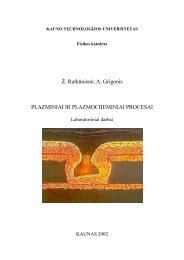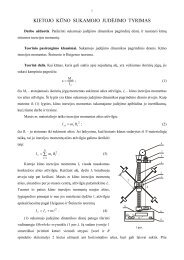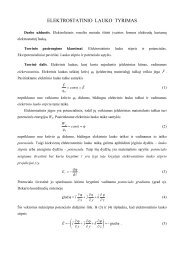PROCEEDINGS OF THE 7 INTERNATIONAL ... - Fizika
PROCEEDINGS OF THE 7 INTERNATIONAL ... - Fizika
PROCEEDINGS OF THE 7 INTERNATIONAL ... - Fizika
You also want an ePaper? Increase the reach of your titles
YUMPU automatically turns print PDFs into web optimized ePapers that Google loves.
MEDICAL PHYSICS IN <strong>THE</strong> BALTIC STATES 7 (2009)<br />
Proceedings of International Conference “Medical Physics 2009”<br />
8 - 10 October 2009, Kaunas, Lithuania<br />
CdTe QUANTUM DOTS STABILIZATION BY PROTEIN IN AQUEOUS<br />
SOLUTION<br />
Vilius PODERYS * , **, Deividas MOTEKAITIS**, Ričardas ROTOMSKIS* , **<br />
* Institute of Oncology Vilnius University, Laboratory of Biomedical Physics;<br />
**Vilnius University, Physics Faculty, Quantum Electronics Department, Biophotonics laboratory<br />
Abstract: Quantum dots – semiconductor fluorescent nanoparticles are very promising fluorescent markers due to their<br />
unique properties. It is very important to know bioeffects of quantum dots before using them in medicine, however it is<br />
still very little known about interaction of quantum dots with biomolecules. In this work we investigated stability and<br />
spectral properties of CdTe quantum dots in aqueous media and effect of quantum dot – protein interaction on these<br />
properties. We showed that BSA stabilizes CdTe quantum dots.<br />
Keywords: Quantum dots, bovine serum albumin, fluorescence spectroscopy, quantum dot – protein interaction<br />
1. Introduction<br />
Since the first time fluorescent semiconductor<br />
nanoparticles (quantum dots) were synthesized, they<br />
are widely explored due to their possible applications<br />
in many fields, including medicine. Tunable emission<br />
wavelength, broad absorption and sharp emission<br />
spectra, high quantum yield (QY), resistance to<br />
chemical degradation and photobleaching, versatility in<br />
surface modification makes quantum dots very<br />
promising fluorescent markers [1].<br />
Quantum dots can be used for live cell labelling ex<br />
vivo, detection and imaging of cancer cells ex vivo [2],<br />
as a specific marker for healthy and diseased tissues<br />
labelling [3], for labelling healthy and cancerous cells<br />
in vivo [4], and for treatment of cancer using<br />
photodynamic therapy [5]. Despite all unique<br />
photophysical properties, some problems must be<br />
solved before quantum dots can be successfully<br />
applied in medicine. Quantum dots usually are water<br />
insoluble and made of materials that are toxic for<br />
biological objects (Cd, Se). To make them suitable for<br />
application in medicine surface of quantum dots has to<br />
be modified to make them water-soluble and resistant<br />
to biological media. After injection of quantum dots to<br />
live organisms they are exposed to various<br />
biomolecules (ions, proteins, blood cells, etc.). This<br />
could lead to degradation of quantum dot coating or<br />
quantum dot itself. In this case toxic Cd 2+ ions are<br />
released and can cause damage to cells or even cell<br />
death. It is very important to know the bioeffects of<br />
quantum dots before using them in medicine. Till now<br />
24<br />
it is still very little known about the interaction of<br />
quantum dots with biomolecules. Recently the interaction<br />
of quantum dots with biomolecules attracted much<br />
interest and is studied using various methods, such as<br />
atomic force microscopy, gel electrophoresis, dynamic<br />
light scattering, size-exclusion high-performance liquid<br />
chromatography, circular dichroism spectroscopy and<br />
fluorescence correlation spectroscopy [6-9].<br />
In this work we investigated stability and spectral<br />
properties of water-soluble CdTe quantum dots coated<br />
with thioglycolic acid in aqueous solutions (deionized<br />
water and saline) and in model media (deionized water<br />
and saline with bovine serum albumin).<br />
2. Materials and methods<br />
Quantum dots solutions were prepared by dissolving<br />
CdTe-TGA quantum dots (λ =(550 ±5) nm, PlasmaChem<br />
GmbH, Germany) in deionized water or saline (0.9%),<br />
and diluting further till required concentration. Prepared<br />
solution was divided in two parts. A small amount of<br />
concentrated bovine serum albumin (BSA) (BSA, V<br />
fraction, M = 69000 g/mol, Sigma, Germany) solution (in<br />
deionized water or saline) was added to one solution and<br />
equal amount of solvent was added to another. Deionized<br />
water was prepared using two stage water cleaning<br />
system (distiller GFL 2008, Germany and deionizer<br />
MicroPure, TKA, Germany). pH values of solvents were<br />
6 and 5.6 for deionized water and saline respectively.<br />
Spectral measurements were performed immediately<br />
after preparation of solutions. Absorbance spectra were<br />
measured with Varian Cary Win UV (Varian Inc.,<br />
Australia) absorption spectrometer. Photoluminescence








